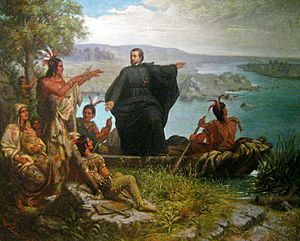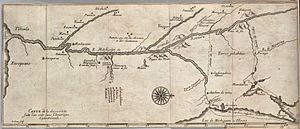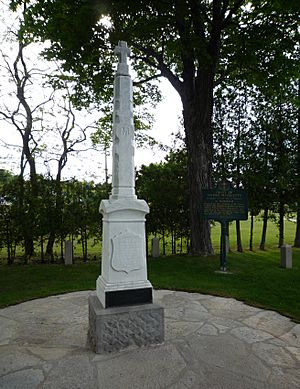Jacques Marquette facts for kids
Quick facts for kids
The Reverend
Jacques Marquette
|
|
|---|---|

1869 portrait of Marquette
|
|
| Born | June 1, 1637 |
| Died | May 18, 1675 (aged 37) near Ludington, Michigan
|
| Other names | Pere Marquette |
| Signature | |
Jacques Marquette (born June 1, 1637 – died May 18, 1675) was a French Jesuit missionary and explorer. He is also known as Père Marquette. He helped start the first European settlement in Michigan, called Sault Sainte Marie. Later, he founded Saint Ignace. In 1673, Marquette and another explorer, Louis Jolliet, were the first Europeans to explore and map the northern part of the Mississippi River Valley.
Contents
Early Life and Training
Jacques Marquette was born in Laon, France, on June 1, 1637. His family was well-known for their service to the community and in the military. When he was 17, Marquette joined the Society of Jesus, a group of Catholic priests and brothers. He studied and taught in France for several years.
In 1666, the Jesuits sent him to New France (which is now Canada) to be a missionary. Missionaries are people who travel to new places to share their religious beliefs. When he arrived in Quebec, he was sent to Trois-Rivières. There, he learned six different local languages. This helped him prepare for his work with the Native peoples.
Exploring the Great Lakes
In 1668, Marquette moved to missions farther west, near the Great Lakes. That year, he helped start a mission at Sault Ste. Marie in what is now Michigan. He also helped found missions at Saint Ignace in 1671 and at La Pointe on Lake Superior in Wisconsin.
At La Pointe, Marquette met members of the Illinois tribes. They told him about a very important trading route: the Mississippi River. They invited him to teach their people, who lived farther south. Because of fighting between tribes, Marquette left La Pointe. He told his leaders about the rumored river and asked for permission to explore it.
Journey to the Mississippi River

Marquette was given permission to explore the river. In 1673, he joined an expedition led by Louis Jolliet, a French-Canadian explorer. They left Saint Ignace on May 17. They had two canoes and five voyageurs, who were skilled travelers of French and Native American background.
They paddled to Green Bay and then up the Fox River. From there, they carried their canoes a short distance over land to the Wisconsin River. This carrying place is now where the town of Portage, Wisconsin, is located. On June 17, they entered the Mississippi River near what is now Prairie du Chien, Wisconsin.
The Joliet-Marquette expedition traveled far down the Mississippi River. They got within about 435 miles of the Gulf of Mexico. However, they decided to turn back at the mouth of the Arkansas River. They had met some Native people who had European items. They worried about meeting explorers or settlers from Spain.
They followed the Mississippi back to the Illinois River. Local Native people told them this river was a shorter way back to the Great Lakes. They reached Lake Michigan near where the city of Chicago is today. In September, Marquette stopped at a mission in Green Bay, Wisconsin. Jolliet continued to Quebec to share the news of their discoveries.
Marquette and his group returned to the Illinois area in late 1674. They were the first Europeans to spend the winter in what would become Chicago. The Illinois Confederation welcomed them. They were given special meals, including ceremonial foods like sagamite.
Death and Burial
In the spring of 1675, Marquette traveled west and held a public church service at the Grand Village of the Illinois. He had become very sick with dysentery during his Mississippi expedition. On his way back to Saint Ignace, he died at 37 years old near the modern town of Ludington, Michigan.
After his death, Native people from the Illinois Confederation brought his bones back to the chapel at Mission Saint-Ignace. Today, a building next to Marquette's gravesite in Saint Ignace houses the Museum of Ojibwa Culture.
Marquette's Legacy
Jacques Marquette is remembered as an important figure in the history of the Great Lakes region. Many places are named after him.
Places Named After Marquette
- Marquette County, Michigan and Marquette County, Wisconsin
- Cities and towns like Marquette, Michigan, Marquette, Iowa, and Marquette, Illinois
- Marquette University in Milwaukee, Wisconsin
- Marquette Island in Lake Huron
- Rivers like the Pere Marquette River in Michigan and the Marquette River in Quebec
- Parks such as Pere Marquette State Park in Illinois and Marquette Park in Chicago
- The Pere Marquette Railway
Monuments and Honors
Marquette is honored with many statues, monuments, and historical markers.
- The Father Marquette National Memorial is near Saint Ignace, Michigan.
- The Chicago Portage National Historic Site honors him and Louis Jolliet.
- Statues of Marquette can be found in places like Detroit, Michigan; Milwaukee, Wisconsin; and even in his birthplace, Laon, France.
- There are also statues of him in the United States Capitol and the Quebec Parliament Building.
- A mural called "Wilderness, Winter River Scene" in the Chicago Public Library shows Marquette trading with Native Americans.
The United States has honored Marquette twice on postage stamps:
- In 1898, a one-cent stamp showed him on the Mississippi River. This was the first time a Catholic priest was honored on a U.S. stamp.
- In 1968, a six-cent stamp was issued to mark 300 years since he started the Jesuit mission at Sault Ste. Marie.
Images for kids
-
Memorial to Marquette in his birthplace of Laon, France
-
Gaetano Trentanove's Marquette statue at the United States Capitol
-
Alfred Laliberté's Marquette sculpture at Quebec Parliament Building
-
Statue of Marquette in Detroit, Michigan
-
Statue of Marquette at Fort Mackinac
-
Statue of Marquette in Marquette, Michigan
-
Statue of Marquette in Prairie du Chien, Wisconsin
-
Marker commemorating Marquette's wintering location in 1674–75, today in Chicago
-
Pere Marquette Memorial in Utica, Illinois
-
Portrait of Marquette at the National Mississippi River Museum & Aquarium
See also
 In Spanish: Jacques Marquette para niños
In Spanish: Jacques Marquette para niños


















